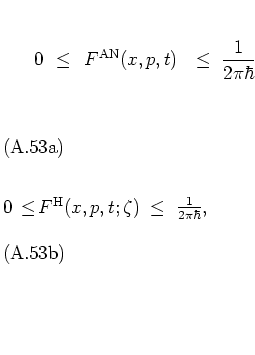![[*]](crossref.png) ff).
Therefore
it now needs to be checked
to what extent the functions
ff).
Therefore
it now needs to be checked
to what extent the functions
The motivation of the theory outlined in this appendix was to construct
distribution functions which can play the same role in quantum mechanics
as the conventional phase space probability densities do in classical
mechanics
(cf. pages ![[*]](crossref.png) ff).
Therefore
it now needs to be checked
to what extent the functions
ff).
Therefore
it now needs to be checked
to what extent the functions ![]() actually have the typical properties of probability densities.
actually have the typical properties of probability densities.
A
``genuine''
phase space probability density ![]() is characterized by
the following properties:A.12
is characterized by
the following properties:A.12

The properties (i)-(iii)
are not automatically satisfied for all distribution functions
![]() ,
but must be checked for each individual
,
but must be checked for each individual ![]() .
They are by no means necessary consequences of the definitions in
sections A.1 and A.2.
On the contrary, it can be shown that for nonzero
.
They are by no means necessary consequences of the definitions in
sections A.1 and A.2.
On the contrary, it can be shown that for nonzero ![]() none of the
known
none of the
known ![]() satisfies all three conditions.
This may be interpreted as a consequence
of HEISENBERG's uncertainty relation and was already
observed by WIGNER in 1932 [Wig32].
This shortcoming of all
distribution functions
satisfies all three conditions.
This may be interpreted as a consequence
of HEISENBERG's uncertainty relation and was already
observed by WIGNER in 1932 [Wig32].
This shortcoming of all
distribution functions
![]() is the reason for using the prefix
quasi in terms like quasiprobability density or quasiprobability
distribution function.
is the reason for using the prefix
quasi in terms like quasiprobability density or quasiprobability
distribution function.
WIGNER's distribution function, for example, is real-valued and gives the
correct
marginal probability distributions for position and momentum,
but it can take on negative values. In fact, it typically oscillates very
rapidly and with large amplitude
between positive and negative values
under variation of ![]() or
or ![]() .
This behaviour of the WIGNER function is
further discussed and demonstrated for some examples
in section
A.6.
.
This behaviour of the WIGNER function is
further discussed and demonstrated for some examples
in section
A.6.
For the antinormal-ordered and the HUSIMI distribution functions one has, using equations
(A.51, A.74),

respectively. Both are real-valued and non-negative. They are even
bounded and do not oscillate as rapidly as ![]() . But, on the
other hand, they do not yield the correct probability densities for
. But, on the
other hand, they do not yield the correct probability densities for ![]() and
and ![]() by
marginalization.
Again I refer the reader to section
A.6 for more details.
Table A.1 gives an overview of the essential properties
of the distribution functions defined in sections A.2
and A.3.
by
marginalization.
Again I refer the reader to section
A.6 for more details.
Table A.1 gives an overview of the essential properties
of the distribution functions defined in sections A.2
and A.3.
It is important to keep in mind that despite the different properties of
the distribution functions, they are all equivalent in the sense that all
of them contain exactly the same information
about
the state of the system.
This can be exploited by choosing that type of distribution
function
![]() (respectively by choosing that kernel function
(respectively by choosing that kernel function ![]() )
that is most suited to study the particular problem in question.
)
that is most suited to study the particular problem in question.
For the purpose of comparing the classical and quantum mechanical
equations of motion of a given system, one usually uses WIGNER's
function (cf. equation (A.82); see [Bun95] for details).
![]() is also especially well suited for the discussion of
scattering systems, because in such systems,
for large energies,
the classical limiting case
often is a good approximation to the exact quantum system already;
equation (A.82) can then be used to
determine
the
quantum
correction terms in a
systematic
way.
On the other hand, if the quantum and classical phase space
(quasi-)
probability densities themselves are in the focus of attention, then most
frequently the HUSIMI distribution function
is also especially well suited for the discussion of
scattering systems, because in such systems,
for large energies,
the classical limiting case
often is a good approximation to the exact quantum system already;
equation (A.82) can then be used to
determine
the
quantum
correction terms in a
systematic
way.
On the other hand, if the quantum and classical phase space
(quasi-)
probability densities themselves are in the focus of attention, then most
frequently the HUSIMI distribution function
![]() or the coherent state representation
or the coherent state representation
![]() are employed.
In section A.6 I discuss some of the advantages of
this choice by considering two familiar quantum states as examples.
are employed.
In section A.6 I discuss some of the advantages of
this choice by considering two familiar quantum states as examples.